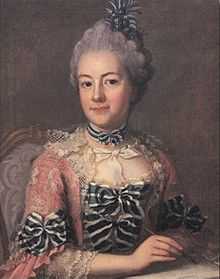Hedvig Charlotta Nordenflycht
| Hedvig Charlotta Nordenflycht | |
|---|---|
 | |
| Born | 28 November 1718 |
| Died | 29 June 1763 |
Cause of death | cancer or suicide |
| Residence | Stockholm, Sweden |
| Occupation | writer and poet |
| Known for | Swedish poet and salon hostess. |
| Spouse(s) | Jacob Fabricius |
Hedvig Charlotta Nordenflycht (Stockholm, Sweden, 28 November 1718 – Stockholm, Sweden, 29 June 1763) was a Swedish poet, feminist and salon hostess. She has been called the first self-supporting female writer in Sweden.
Biography
.png)
Born in Stockholm, Nordenflycht was the daughter of the official Anders Andersson Nordbohm, who was ennobled as Nordenflycht, and Christina Rosin. She was given a good education where she early read philosophy, theology, Latin and German.
In 1734 she was engaged to Johan Tideman, who was sickly. He had an impact on her and was an inspiration to her as a follower of Christopher Polhem. He died in 1737, before the wedding. She married Jacob Fabricius, military-vicar in Karlskrona, but he died very soon after the wedding. She withdrew to a cottage to mourn, and there, she wrote her first poems to describe her sorrow.
Hedvig Charlotta Nordenflycht began her career by a poem dedicated to the throne accession of the king of Prussia in 1740, and received great encouragement from the court, especially from Queen Louisa Ulrika, which gave her a lot of support and protected her work, a support she repaid with numerous poems of appreciation to the royal house. She could be regarded as somewhat of a court poet. She became fashionable and supported herself by writing poems on commission. In 1752, she received a pension from the state.
In 1753 she was elected into the Tankebyggarorden, a literary academy in Stockholm based on similar French societies, which published several works which are regarded as the breakthrough of literary classicism in Sweden. She became a leading member of the academy, acted as its hostess and made it the centre of a literary salon. Her name in the Academy was Uranie, and she was a close friend to Gustaf Philip Creutz and Gustaf Fredric Gylleborg.
She was a passionate defender of female education. As such, she opposed some of the views of Rousseau. In 1761, she wrote Fruntimrens försvar (English: "To the Defense of Women") on this topic. In Friarekonsten (English: "The art of proposing"), she warns women, that men's assurances of friendship often turned to a demand of obedience after marriage.
Nordenflycht is said to have been a passionate and emotional person. The sorrows of her private life affected her health and made her sick and depressed, some say suicidal, which is said to have been reflected in her works, which was often of the melancholic kind. The most famous poem of Nordenflycht, Öfver en Hyacint, was a love poem which describes Nordenflycht's love for the young Johan Fischerström; the last poems is about the triangle between Nordenflycht, Fischerström and her friend Cathérine Charlotte De la Gardie, which took place during the winter of 1762–63. In 1762, she withdrew to a cottage at the estate of De la Gardie; Johan Fischerström became the inspector of the estate and courted De la Gardie, which made the situation unbearable for Hedvig. Her health was also declining. Legend say she committed suicide, and several versions are given as to how it happened. Other historians, however, find it likely that she suffered from cancer.
In the national Swedish portrait gallery of Gripsholm, which was opened in the 1820s, she was one of the first six women of the Swedish history who was given a portrait in the collection, alongside with Bridget of Sweden, Vendela Skytte, Barbro Stigsdotter (Svinhufvud), Sophia Rosenhane and Sophia Elisabet Brenner.
Selection of work
- 1743 : "Den sörjande Turturduvan" (The Sorrowing Turtledove)
- 1744 : Qwinligit Tankespel, av en herdinna i Norden (A Woman's Play of Thoughts, by a Shepherdess in the North), in four volumes between 1744 and 1750
- 1744 : Fruentimbers Plikt att upöfwa deras Wett (Women's duty to train their sense)
- 1752 : Våra Försök (Our Efforts), together with the other academy members
- 1761 : Fruntimrens försvar (To the Defense of Women)
- 1762 : Öfwer en hyacinth (Over a hyacinth)
See also
- Anna Maria Lenngren
- Sophia Elisabet Brenner
- Catharina Ahlgren
- Hedvig Catharina Lilje
References
- Hedvig Charlotta Nordenflycht, av Hilma Borelius, 1922, Lund. (Swedish)
- Carin Österberg: Svenska kvinnor: Föregångare, nyskapare (Swedish women: Predecessors, pioneers) 1990 (Swedish)
- Signum Svenska kulturhistoria: Gustavianska tiden (Swedish)
- A.L. Stjerneld (anonym), Gripsholmgalleriet (Stockholm 1833) (Swedish)
External links
|